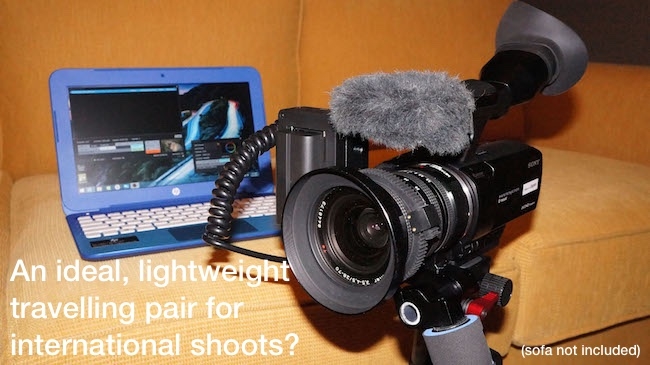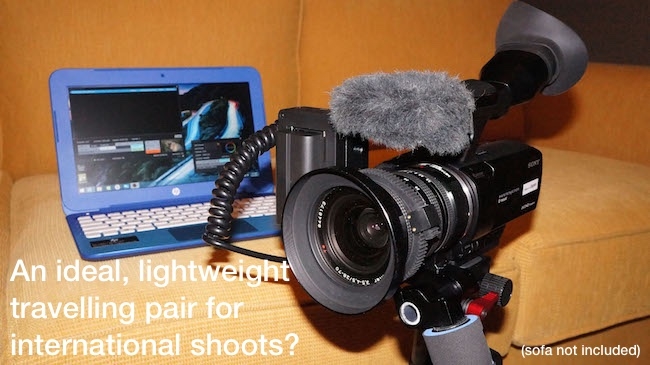

Travelling companions. In looking for a lightweight, portable and cheap kit list for an international shoot, Craig Marshall hit upon pairing his Ninja Star recorder with an HP notebook PC.
As a follow up to my previous RedSharkNews article about safely rigging the Ninja Star ProRes recorder, I wanted to explore a lightweight ‘travelling’ scenario as I have another HD music video shoot coming up soon in Kyoto, Japan. For this project, I want to be able to shoot at the highest possible quality with my current setup but be able to travel internationally with only the minimum of equipment.
Lightweight
To this end, I re-rigged my camera to include the Ninja Star recorder but without the weight and complexity of matte box, C handle and top handle yet still be in a position to backup and review files on location. I’ll admit to favouring the perspective afforded by long lenses, but without a big heavy fluid tripod they are next to useless, so my Zeiss 300mm F4, weighing in at nearly 2Kg, stays home.
I shoot through a collection of classic full frame Zeiss ‘Contax’ prime and zoom lenses so I use a Metabones ‘Speed Booster’ to adapt these manual ‘analogue’ lenses to a modern video camera with a Super 35/APS-C ‘digital’ CMOS sensor. This configuration retains the lens’ original Field of View whilst affording an extra stop of light to the sensor. As the Speed Booster is fitted with its own Arca Swiss quick release foot, this became an invitation to fit a pair of short, lightweight rails directly to the camera’s own base plate onto which I could clamp a pistol grip on one side and mount the Star recorder on the other. Under this arrangement, my LH thumb and finger can adjust focus/iris/zoom whilst my RH little finger can start and stop the Star’s ProRes recordings. This arrangement leaves the Speed Booster’s tripod mount free so that the camera can be quickly adapted to any suitable surface fitted with a mating quick release plate.
On location
The Ninja Star HDMI recorder is very small, lightweight with low power requirements because it records to CFast cards. One disadvantage is that, when compared to SD cards or even SSDs of the same capacity, CFast cards are very expensive. A 64GB CFast card costs around $150 and record only 30 minutes of ProRes at the highest quality setting so I generally shoot until the card is nearly full, then dump the files off to a backup drive. When travelling, I could scout around for an internet café with a PC and a couple of USB ports but after some quick research online, I hit on a better solution…
Enter the HP Stream 11 Notebook PC
Wondering about the potential of a modern tablet solution, I stumbled across HP’s latest ‘Stream’ PC. This cute little ‘notebook’ style computer weighs in at just 1.25Kg but is equipped with a real QWERTY keyboard, WiFi, BlueTooth and a 1366 x 768 60Hz 11.6” screen with a five hour lithium battery, all under Win 8.1 management. This remarkably cheap device (around $250) sports a full sized SD card reader, 2GB RAM plus a small internal SSD but it also has audio headphone and HDMI outputs. Best of all though, it has two USB ports! (one port is USB3.0).
The Ninja Star comes with a USB3 CFast card reader/writer so with this plugged into the HP Stream and my 2TB portable HDD plugged into the other USB socket, I can quickly transfer, copy or backup files from the CFast card to the portable drive, thereby allowing quick re-use of the expensive ProRes recording format.
There is another advantage to this arrangement too. Although my camera offers a ‘clean’ HDMI output to the Ninja Star, it does not generate timecode internally. Consequently, a timecode of 00:00:00:00 is recorded on each of the Ninja Star’s ProRes files and this would normally play havoc in post production. But fortunately, there’s a simple solution and it’s free! I installed ClipToolz ‘Convert’ v2.1 on the HP Stream so I can use it’s included Timecode Tool to manually set or ‘re-stripe’ the ProRes timecode during the transfer of files from CFast to HDD. ClipToolz also offers a ‘sequential’ timecode re-stripe facility so that the timecode settings increment.
As well as being an excellent transcoder with all the major codecs installed, ClipToolz also enables ProRes encoding on a PC and there’s a further option too: because my camera can be set up to record 50p AVCHD internally but output a different HDMI signal to the Ninja Star, I can later use ClipToolz ‘PTS’ feature to transcode create an ultra smooth 50% slow motion ProRes HQ 25p file from the camera’s internal 50p AVCHD recording. ClipToolz Convert also includes a nice set of scopes to check your files on location – much more reliable and convenient than a cheap HDMI monitor.
All in all: the packing list
- Super 35 Camera body with Ninja Star HDMI recorder and lightweight rails
- Metabones C/Y to E-Mount ‘Speed Booster’
- 50mm F1.7 Zeiss prime
- 25mm F2.8 Zeiss prime
- 135mm F2.8 Zeiss prime
- 180mm F2.8 Zeiss prime (maybe)
- 28-70mm F3.5 Zeiss zoom
- HP Stream Notebook PC
- USB 3 CFast card reader/writer
- USB 3 2TB Portable HDD
- ClipToolz, VLC and Mediainfo installed
- Lightweight Aluminium Tripod with Fluid pan-head
- Spare batteries, SD Cards & CFast card
- Lightweight ‘switchmode’ battery charger/s
Tags: Production


Comments